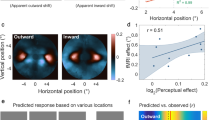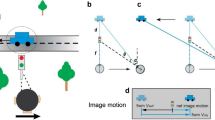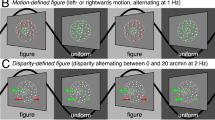Abstract
When two stationary visual objects appear in alternating sequence, they evoke the perception of a single object moving back and forth between them. This is known as stroboscopic or apparent motion and forms the basis of perceived continuity in, for example, motion pictures. When the spatiotemporal separation between the inducing objects is optimal, the subjective appearance of apparent motion is nearly indistinguishable from that of real motion. Here we report that the detection and identification of a simple visual form in the path of apparent motion is impaired by the illusory perception of an object moving through the empty space between the locations at which the inducing objects are presented. This observation may be a manifestation of perceptual completion or 'filling in' during apparent motion perception. We propose that feedback from higher to lower visual cortical areas activates an explicit neural representation of a moving object, which can then disrupt the representation of visual stimuli in the path of the movement.
This is a preview of subscription content, access via your institution
Access options
Subscribe to this journal
Receive 12 print issues and online access
$209.00 per year
only $17.42 per issue
Buy this article
- Purchase on Springer Link
- Instant access to full article PDF
Prices may be subject to local taxes which are calculated during checkout




Similar content being viewed by others
References
Kanizsa, G. Organization in Vision (Prager, New York, 1979).
Kellman, P. J. & Shipley, T. F. A theory of visual interpolation in object perception. Cogn. Psychol. 141– 221 (1991).
Michotte, A., Thinès, G. & Crabbé, G. in Michotte's Experimental Phenomenology of Perception (eds Thinès, G., Costall, A. & Butterworth, G.; trans Miles, E. & Miles, T. R.) 140– 167 (Erlbaum, Hillsdale, New Jersey, 1991; originally published 1964).
Rock, I. The Logic of Perception (MIT Press, Cambridge, Massachusetts, 1983).
Shimojo, S. & Nakayama, K. Amodal representation of occluded surfaces: Role of invisible stimuli in apparent motion correspondence. Perception 19, 285–299 (1990).
von der Heydt, R., Peterhans, E. & Baumgartner, G. Illusory contours and cortical neuron responses. Science 224, 1260–1261 (1984).
Wertheimer, M. Experimentelle studien über das sehen von bewegung. Z. Psychol. 61, 161–265 (1912).
Kolers, P. A. Aspects of Motion Perception (Pergamon, New York, 1972).
Burt, P. & Sperling, G. Time, distance, and feature trade-offs in visual apparent motion. Psychol. Rev. 88, 171–195 (1981).
Ramachandran, V. S. & Anstis, S. M. Perceptual organization in moving patterns. Nature 304, 529– 531 (1983).
Albright, T. D. & Stoner, G. R. Visual motion perception. Proc. Natl. Acad. Sci. USA 92, 2433–2440 (1995).
Shepard, R. N. & Judd, S. A. Perceptual illusion of rotation of three-dimensional objects. Science 191 , 952–954 (1976).
Robins, C. & Shepard, R. N. Spatio-temporal probing of apparent rotational movement. Percept. Psychophys. 22, 12–18 (1977).
Beck, J., Elsner, A. & Silverstein, C. Position uncertainty and the perception of apparent motion. Percept. Psychophys. 21, 33– 38 (1977).
Farrell, J. E. & Shepard, R. N. Shape, orientation, and apparent rotational motion. J. Exp. Psychol. Hum. Percept. Perform. 7, 477–486 (1981).
Bundesen, C., Larsen, A. & Farrell, J. E. Visual apparent movement: Transformations of size and orientation. Perception 12, 549– 558 (1983).
Hock, H. S., Kelso, J. A. S. & Schöner, G. Bistability and hysteresis in the organization of apparent motion patterns. J. Exp. Psychol. Hum. Percept. Perform. 19, 63–80 (1993).
Korte, A. Kinematoskopische untersuchungen. Z. Psychol. 72, 194–296 (1915).
Neuhaus, W. Experimentelle untersuchung der scheinbewegung. Arch. Ges. Psychol. 75, 315–458 (1930).
Cavanagh, P. Attention-based motion perception. Science 257, 1563–1565 (1992).
Yantis, S. Multielement visual tracking: Attention and perceptual organization. Cogn. Psychol. 24, 295–340 (1992).
Horowitz T. & Treisman, A. Attention and apparent motion. Spatial Vis. 8, 193–219 (1994).
Shepard, R. N. & Zare, S. L. Path-guided apparent motion. Science 220, 632– 634 (1983).
Kolers, P. A. Some differences between real and apparent visual movement. Vision Res. 3, 191–206 (1963).
Attneave, F. & Block, G. Absence of masking in the path of apparent movement. Percept. Psychophys. 16, 205–207 (1974).
Mikami, A., Newsome, W. T. & Wurtz, R. H. Motion selectivity in macaque visual cortex. II. Spatiotemporal range of directional interactions in MT and V1. J. Neurophysiol. 55, 1328–1339 (1986).
Newsome, W. T., Mikami, A. & Wurtz, R. H. Motion selectivity in macaque visual cortex. III. Psychophysics and physiology of apparent motion. J. Neurophysiol. 55, 1340–1351 (1986).
Mikami, A. Direction selective neurons respond to short-range nd long-range apparent motion stimuli in Macaque visual area MT. Int. J. Neurosci. 61, 101–112 (1991).
Zeki, S. & Shipp, S. The functional logic of cortical connections . Nature 335, 311–317 (1988).
Felleman, D. J. & Van Essen, D. C. Distributed hierarchical processing in the primate cerebral cortex. Cereb. Cortex 1, 1–47 (1991).
Sillito, A. M, Jones, H. E., Gerstein, G. L. & West, D. C. Feature-linked synchronization of thalamic relay cell firing induced by feedback from the visual cortex. Nature 369, 479– 482 (1994).
Ramachandran, V. S. & Gregory, R. L. Perceptual filling in of artificially induced scotomas in human vision. Nature 350, 699–702 (1991).
De Weerd, P., Gattass, R., Desimone, R. & Ungerleider, L. G. Responses of cells in monkey visual cortex during perceptual filling-in of an artificial scotoma. Nature 377, 731– 734 (1995).
Hogben, J. H. & Di Lollo, V. Suppression of visible persistence in apparent motion. Percept. Psychophys. 38, 450–460 (1985).
Watamaniuk, S. N. Visible persistence is reduced by fixed-trajectory motion but not by random motion. Perception 21, 791– 802 (1992).
Van Essen, D. C. & Gallant, J. L. Neural mechanisms of form and motion processing in the primate visual system. Neuron 13, 1–10 (1994 ).
Breitmeyer, B., Love, R. & Wepman, B. Contour suppression during stroboscopic motion and metacontrast . Vision Res. 14, 1451– 1456 (1974).
Breitmeyer, B. G. Visual Masking (Oxford Univ. Press, New York, 1984).
Grossberg, S. & Rudd, M. E. Cortical dynamics of visual motion perception: Short-range and long-range apparent motion. Psychol. Rev. 99, 78–121 (1992).
Baloch, A. A. & Grossberg, S. A neural model of high-level motion processing: line motion and formotion dynamics. Vision Res. 37, 3037–3059 (1997).
Finkel, L. H. & Edelman, G. M. Integration of distributed cortical systems by reentry: a computer simulation of interactive functionally segregated visual areas. J. Neurosci. 9, 3188– 3208 (1989).
Tononi, G., Sporns, O. & Edelman, G. M. Reentry and the problem of integrating multiple cortical areas: simulation of dynamic integration in the visual system. Cereb. Cortex 2, 310–335 (1992).
Levitt, H. Transformed up-down methods in psychoacoustics. J. Acoust. Soc. Am. 49, 467–477 (1971).
Acknowledgements
We thank C. Bundesen, C. Connor, V. Di Lollo, H. Egeth, J. Enns and M. Rudd for valuable discussions. This work was supported by grant R01-MH43924 from the U.S. National Institute of Mental Health.
Author information
Authors and Affiliations
Corresponding author
Rights and permissions
About this article
Cite this article
Yantis, S., Nakama, T. Visual interactions in the path of apparent motion. Nat Neurosci 1, 508–512 (1998). https://doi.org/10.1038/2226
Received:
Accepted:
Issue Date:
DOI: https://doi.org/10.1038/2226
This article is cited by
-
Dynamic perceptual completion and the dynamic snapshot view to help solve the ‘two times’ problem
Phenomenology and the Cognitive Sciences (2020)
-
Cues to intention bias action perception toward the most efficient trajectory
Scientific Reports (2019)
-
Time-compressed preplay of anticipated events in human primary visual cortex
Nature Communications (2017)
-
Theories of apparent motion
Phenomenology and the Cognitive Sciences (2016)
-
Time perception during apparent biological motion reflects subjective speed of movement, not objective rate of visual stimulation
Experimental Brain Research (2013)



